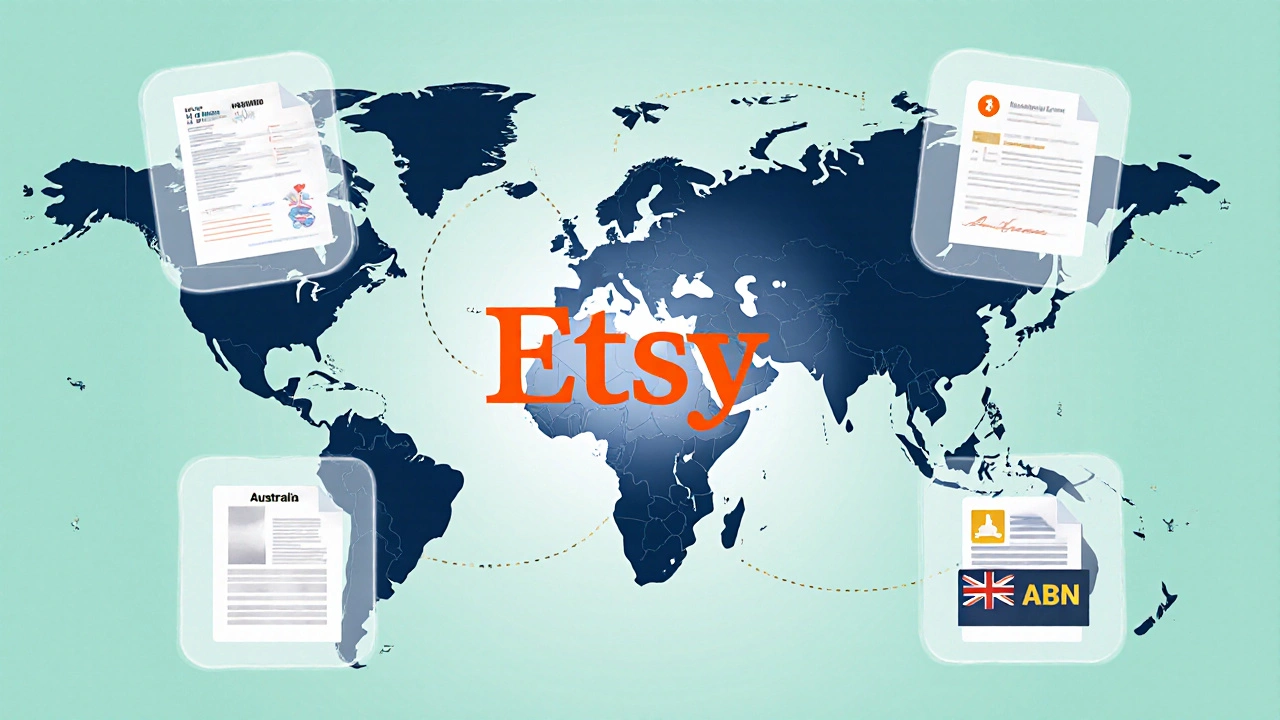Etsy Tax ID Threshold Calculator
When you open a shop on Etsy is a global marketplace that lets artists, crafters, and digital creators list products to millions of buyers worldwide. One of the first questions that pops up is whether you need a Tax Identification Number (TIN) (often called a tax ID) to start selling. The answer isn’t a simple yes or no-it depends on where you live, what you sell, and how much you earn each year. In this guide we’ll walk through the rules for the United States, Canada, and a few other common jurisdictions, show you how to apply for the right ID, and flag the tax reporting forms you’ll see on your Etsy dashboard.
Why Etsy cares about a tax ID
Etsy is considered a “marketplace facilitator” in many countries. That label means the platform is legally required to collect and remit certain taxes on behalf of its sellers, and to report sales to tax authorities when sellers cross specific thresholds. Without a valid tax ID, Etsy can’t match your sales data to the proper government record, which can trigger payment holds or even account suspension.
U.S. sellers: Which ID do you need?
In the United States the Internal Revenue Service (IRS) uses three main identifiers for individuals and businesses:
- Social Security Number (SSN) - for sole proprietors who operate under their own name.
- Employer Identification Number (EIN) - for LLCs, corporations, partnerships, or sole proprietors who prefer a business‑only number.
- Individual Taxpayer Identification Number (ITIN) - for non‑resident aliens who can’t get an SSN.
If you earn less than $100,000 in a calendar year and have fewer than 200 transactions, Etsy will not issue a Form 1099‑K, but you still need to provide an SSN or EIN in your “Tax Information” section. Once you cross either threshold, Etsy automatically generates a 1099‑K that references the ID you supplied.
Canadian creators: Do you need a CRA business number?
Canada’s tax authority, the Canada Revenue Agency (CRA), works a bit differently. For most individual artists selling digital downloads, a Social Insurance Number (SIN) is sufficient for reporting income on your personal tax return. However, if you register a formal business-say a sole‑prop corporation or a partnership-you’ll be issued a Business Number (BN) that doubles as a GST/HST account number.
Etsy Canada requires a BN if you charge Canadian sales tax (GST/HST) on your listings. The platform will prompt you to enter the BN during the “Tax Settings” workflow. If you don’t collect GST/HST, you can still list items, but you must report the earnings on your personal tax filing using your SIN.
When a tax ID becomes mandatory
Below is a quick matrix that shows the trigger points for the most common jurisdictions. If you hit any of the shaded boxes, you must supply the appropriate ID within 30 days, or Etsy may pause your payouts.
| Country | Annual Gross Sales Threshold | Transaction Count Threshold | Required ID |
|---|---|---|---|
| United States | $100,000 | 200 | SSN or EIN |
| Canada | CAD 30,000 (GST/HST) | - | SIN (personal) or BN (business) |
| United Kingdom | £85,000 (VAT) | - | VAT registration number |
| Australia | AUD 75,000 (GST) | - | ABN (Australian Business Number) |

How to apply for your tax ID
Step 1 - Determine the right entity type. If you’re a hobbyist selling occasional prints, your personal SSN or SIN will likely suffice. If you plan to scale, form an LLC (U.S.) or register a sole‑prop corporation (Canada) and get an EIN or BN.
Step 2 - Gather required documents. In the U.S., you’ll need a driver’s license or passport, plus your legal business name. The IRS offers an online EIN application that completes in minutes. Canadian entrepreneurs can apply for a Business Number through the CRA’s “Business Registration Online” portal.
Step 3 - Submit the ID to Etsy. Log into your Etsy account, go to Shop Manager → Finances → Tax Settings, and enter the number exactly as it appears on the official document. Double‑check the format-extra dashes or spaces can cause validation errors.
Step 4 - Keep records. Store the confirmation emails and the official tax‑ID letters in a secure folder. You’ll need them when filing your annual return and if Etsy requests proof.
Common pitfalls and how to avoid them
- Mismatched names. The name on your Etsy profile must match the name associated with the tax ID. If you file as an LLC but list your personal name, Etsy’s system will flag the mismatch.
- Late submissions. After crossing a reporting threshold, Etsy sends an automated email. Ignoring it for more than 30 days can freeze payouts.
- International sales confusion. If you sell to buyers in Europe, you may also need a VAT ID-even if you already have a U.S. EIN. Separate the two in your tax settings.
- Using a personal SSN for a high‑volume shop. This can raise audit flags. Consider upgrading to an EIN once your monthly revenue exceeds a few thousand dollars.
What the 1099‑K looks like on Etsy
When you hit the $100,000 or 200‑transaction mark, Etsy automatically generates a Form 1099‑K for the previous calendar year. You’ll find a downloadable PDF under Shop Manager → Finances → Tax Documents. The form lists “Gross Payment Card/Third‑Party Network Transactions” and includes the tax ID you supplied.
If the ID is missing or incorrect, Etsy will label the form as “NO TAX ID PROVIDED,” which can trigger an IRS notice. That’s why entering the correct number early on saves you a lot of headaches later.

Beyond the tax ID: Other compliance steps for Etsy sellers
Having the right ID is just one piece of the puzzle. Here are a few extra actions that keep your shop running smoothly:
- Register for sales tax collection. In most U.S. states, Etsy now automatically collects and remits sales tax for you, but you must enable the feature in your tax settings.
- Issue receipts. Even though Etsy sends order confirmations, keeping a separate ledger of each sale helps during tax season.
- Separate personal and business finances. Open a dedicated bank account for your Etsy earnings; this makes bookkeeping cleaner and reduces audit risk.
- Track deductible expenses. Supplies, software subscriptions (like Photoshop), and even a portion of your home internet can be written off if you’re operating as a business.
Quick reference checklist
- Do you earn tax ID under your personal name? Use SSN (US) or SIN (Canada).
- Planning to scale? Apply for EIN (US) or BN (Canada) before hitting $5,000/mo.
- Crossed $100K/200 transactions (US) or CAD 30K (Canada)? Submit the ID within 30 days.
- Enable automatic sales‑tax collection in Shop Manager → Finances → Tax Settings.
- Keep a copy of the 1099‑K (US) or T‑5013 (Canada) for your records.
Frequently Asked Questions
Do I need a tax ID if I only sell a few digital prints a year?
If your total yearly sales stay below the reporting thresholds (e.g., $100,000 in the U.S. or CAD 30,000 in Canada), Etsy will not require a formal tax ID for reporting purposes. You can use your personal SSN or SIN for the small amount of income you report on your personal return.
Can I use my partner’s EIN for my Etsy shop?
Only if the business is legally shared. The EIN belongs to the entity that applied for it. Using someone else’s number can be considered fraud and may lead to account termination.
What happens if I ignore Etsy’s request for a tax ID?
Etsy will place a hold on future payouts until the required information is provided. Repeated neglect can trigger a permanent suspension of your shop.
Do I need to charge sales tax on digital downloads?
Rules vary by state. Some U.S. states tax digital products, while others don’t. Etsy’s automatic tax‑collection setting follows the latest state laws, so enable it to stay compliant.
How do I report my Etsy earnings on my personal tax return?
In the U.S., list the net profit on Schedule C if you’re a sole proprietor. In Canada, report the income on the T2125 form (Statement of Business Activities). Attach any 1099‑K or T‑5013 you receive from Etsy.
Understanding when a tax ID is required saves you from surprise payment holds, fines, and tax headaches. Whether you’re a Vancouver‑based digital illustrator selling printable art or a U.S. graphic designer offering custom logos, the steps outlined here will keep your Etsy shop compliant and focused on what matters most-creating great art.



